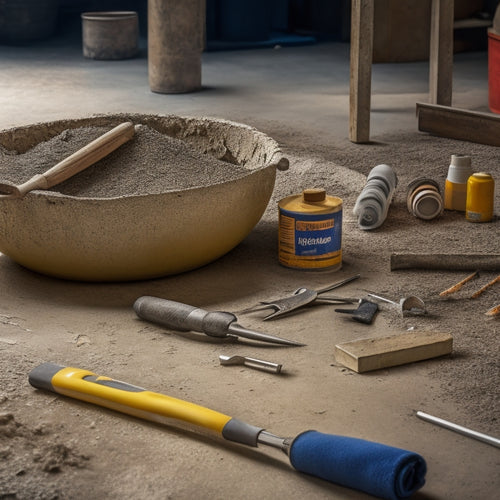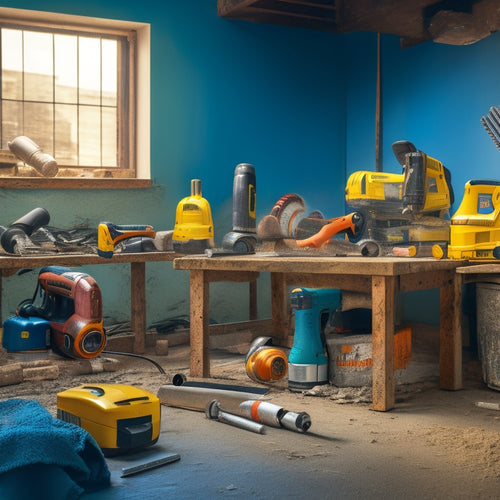
3 Best Tools for Perfect Concrete Consistency
Share
To achieve perfect concrete consistency, you'll need the right tools. First, a slump cone and tamping rod guarantee accurate slump measurement, while temperature sensors and humidity gauges monitor environmental conditions that impact workability and strength. Third, a data logger or smart monitoring system provides insights into trends and conditions, helping you adjust your mix and pouring process accordingly. By using these three essential tools, you'll be well on your way to achieving a consistent concrete mix that meets your project's requirements; and with a deeper understanding of the complex factors at play, you'll be empowered to make the subtle adjustments that separate success from failure.
Key Takeaways
• Accurate slump measurement is ensured with a reliable slump cone and tamping rod to achieve ideal workability and finishing characteristics.
• Temperature sensors and data loggers monitor concrete temperature to prevent excessive heat, which can cause cracking and reduce strength.
• Humidity gauges and smart monitoring systems track ambient humidity, enabling adjustments to mixing water and preventing excessive moisture.
• Advanced mixing techniques, such as sequential and intensive mixing, help eliminate inconsistencies in the mixture for uniform concrete consistency.
• Material selection and proper material handling are critical to prevent contamination and degradation, ensuring high-quality concrete with desired properties.
Ensuring Uniform Mix Consistency
To achieve consistent concrete quality, you must closely monitor and control the mixing process to confirm uniform mix consistency, as even slight variations can greatly impact the final product's strength, durability, and appearance.
You can't afford to compromise on this vital step, as it sets the stage for the entire construction project.
To maintain uniformity, you should employ advanced mixing techniques, such as sequential mixing or intensive mixing, which help to eliminate any inconsistencies in the mixture.
Material selection is also essential, as it directly influences the final product's properties.
You must carefully choose the right cement type, aggregate size, and admixtures to achieve the desired concrete characteristics.
Additionally, you should make certain that all materials are stored and handled properly to prevent contamination or degradation.
Achieving Ideal Slump Control
You require a slump between 1 and 4 inches to guarantee ideal workability and finishing characteristics in your concrete. This range ensures your mixture is neither too stiff nor too flowable, allowing for efficient placing, finishing, and overall quality.
To achieve this ideal slump, you need to accurately measure the slump of your concrete. A slump cone and tamping rod are vital tools for this task. Simply fill the cone with fresh concrete, lift it, and measure the resulting slump. This measurement will guide your adjustments to the mix design.
When it comes to making these adjustments, water additives play a significant role. By adding the right amount of water-reducing admixtures, you can fine-tune your slump without compromising strength or durability.
It's fundamental to note that excessive water addition can lead to segregation, honeycombing, and reduced structural integrity. As a result, precise slump measurement and controlled water addition are critical to achieving ideal slump control.
Monitoring Temperature and Humidity
As you endeavor to maintain ideal slump control, you're also aware that temperature and humidity greatly impact concrete's workability, setting time, and ultimate strength.
These environmental factors can greatly affect the final product's quality, making it essential to monitor them accurately. To guarantee optimal concrete consistency, you'll need reliable tools to track temperature and humidity levels.
Here are the important tools you'll need:
-
Temperature sensors: Accurately measure concrete temperature to prevent excessive heat, which can lead to cracking and reduced strength.
-
Humidity gauges: Monitor ambient humidity levels to adjust mixing water accordingly, preventing excessive moisture that can compromise concrete's integrity.
-
Data loggers: Record temperature and humidity data to analyze trends, identify patterns, and make informed decisions.
-
Weather stations: Provide real-time weather data, enabling you to adjust your concrete mixing and placement schedule accordingly.
-
Smart concrete monitoring systems: Integrate temperature, humidity, and other sensors to provide an all-encompassing picture of your concrete's conditions.
Frequently Asked Questions
Can I Use a Single Tool for Both Mixing and Finishing Concrete?
When it comes to concrete work, you're wondering if you can use a single tool for both mixing and finishing.
While it's technically possible, it's not the most effective or safe approach. You'll compromise on mixing techniques, potentially leading to inconsistent concrete, and finishing methods will suffer as well.
It's better to dedicate separate tools to each task to guarantee the best results and a safe working environment.
How Often Should I Calibrate My Concrete Testing Equipment?
You need to prioritize equipment accuracy to guarantee reliable test results.
Calibration frequency depends on usage and manufacturer guidelines. Typically, you should calibrate your concrete testing equipment every 1-3 months or after 100-200 uses.
Regular calibration prevents inaccurate readings, guaranteeing the safety of your structures and workers.
Don't compromise on accuracy – calibrate your equipment according to the schedule to maintain precision and reliability.
Are There Any Tools Specifically Designed for Working With Colored Concrete?
As you dip your trowel into the vibrant sea of colored concrete, you're not just building a structure - you're crafting a work of art.
When working with colored concrete, you need tools that'll help you achieve a consistent, stunning finish. You'll want to invest in specialized colored concrete mixers that guarantee uniform pigment distribution.
Additionally, pigment dispersion tools will help you achieve the perfect hue. With these tools, you'll be able to bring your colorful vision to life, safely and precisely.
Can I Use a Drill Mixer for Large Commercial Concrete Projects?
When tackling large commercial concrete projects, you're likely wondering if a drill mixer is up to the task.
While drill mixers offer benefits like increased mixing speed and efficiency, they mightn't be the best choice for large-scale projects.
Commercial project considerations, such as high-volume mixing and intense labor demands, may outweigh the drill mixer's capabilities.
You'll want to assess your project's specific needs and consider more heavy-duty equipment to guarantee a safe and successful outcome.
Do I Need to Invest in Separate Tools for Different Types of Cement?
Imagine yourself standing on a construction site, surrounded by cement bags with varying labels. You're wondering if you need separate tools for each type. The answer is yes.
Different cement types require specific mixing techniques to verify ideal results. Using the wrong tool can compromise the concrete's integrity, putting the entire structure at risk.
Invest in tools designed for each cement type to assure a safe and successful project.
Conclusion
You've finally mastered the art of achieving perfect concrete consistency, and it's a game-changer!
With the right tools, you can guarantee uniform mix consistency, ideal slump control, and monitor temperature and humidity like a pro.
Now, you can produce concrete that's as smooth as silk and as strong as a thousand suns.
Your construction projects will soar to new heights, and your reputation will solidify (pun intended) as a master concrete craftsman.
Related Posts
-

What Tools Do I Need for Concrete Wall Repair
As you prepare for a concrete wall repair job, you'll need a variety of tools to guarantee a successful outcome. Star...
-

Top Tools for Repairing Cracked Concrete Surfaces
When tackling a cracked concrete surface repair, you'll need the right tools to guarantee a durable fix. Start with e...
-

Essential Power Tools for Concrete Block Construction
When building with concrete blocks, you'll need a range of power tools to cut, drill, mix, and finish the blocks to g...


